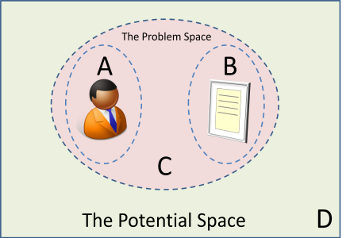Table of Contents
Potential Space and Playing
Introduction
“Imagination is more important than knowledge. For while knowledge defines all we currently know and understand, imagination points to all we might discover and create.” - Albert Einstein
The potential space is the space outside of the problem space, this space also has its own set of boundaries, it could be considered to be an area of freedom, where there is no control and therefore is where the individual assumes responsibility, and develops self-control.
Figure 14
Entering the Potential Space
As the client shifts and moves the boundaries of the problem space into the area of the potential space, this new set of boundaries gives form and meaning to each wider circle within which there is increased freedom of ideas and functioning.
Through the act of drawing and with a sense of play, the client is enabling themselves to access their potential space. Recent research work is showing that the use of ‘play therapy’ with children is very powerful, we are utilising a similar function of the human neurology with this work.
The Nature of the Potential Space
The potential space is also concerned with symbols, the meaning of meaning and is the basis of creativity, where what is conceived of is then superimposed on the external reality, to be then found and discovered. This ability to create in this way, originates from the adaptation of need where external reality is imposed on what the infant conceives of.
In summing up then, we are looking to provide opportunities of expanding outside of the problem space into the potential space.
